Archive for ‘Notes and Notebooks’ Category
Noteworthy Notebooks (Part 4): Modular, Customizable, Disc-Based Notebooks
THE MOD SQUAD: MODULAR NOTEBOOKS
The key to organizing is knowing what works for you; one size rarely fits all, and this is especially true when writing down your thoughts.
Some people just need a drugstore composition notebook while others want to feel their notebooks are as special and magical as their thoughts. To make a notebook truly your own, one option is to select modular, customizable notebooks where you can decide what goes into it, what order everything goes in, and have the ability to change it whenever you want.
Simple perforated notepads, like legal pads with the paper perforated at the top (as I described last time) have the advantage of not being too nice, so you’re unlikely to experience perfectionist procrastination. You can just tear out your mistakes. But alas, they give you no customization.
Similarly, saddle-stitched and perfect-bound notebooks, which give you the feeling that your notes or journal are being created in an already published book and you’re just adding the words, have great aesthetic appeal, but you can’t move the pages around.
The next category of notebooks are spiral bound, whether the down-market one-coil spiral notebook you might use for school, or the double or Wire-O binding we’ve seen in some of the nicer notebooks in this series so far. But again, everything is always stuck in the same order.
Of course, you can opt for ring binders; there’s a reason three-ring binders have been popular with students for the past century. They come in myriad sizes and can be customized with a quick opening of the rings and shuffling of the papers; add tabs for labeling, and voilà. But ring binders, even the smallest, are bulky, and it’s difficult to write on the left side or reverse of pages (or at all, if you’re a lefty). And with a binder open, it takes up a lot of desktop real estate.
Hence the rise in popularity of disc-based notebooks.
DISC-BASED NOTEBOOKS
Disc-based notebooks are classic; they’ve been popular in Europe since the middle of the last century. They are attractive, versatile, and most importantly for their fans, customizable.
Each disc-based notebook has the following components: a front and back cover, loose sheets of paper that have been punched—not with three round holes but with a number of sideways umbrella or mushroom punched shapes, and button-like disks (often metal or plastic) that align with the punched section.
Because the punches are made very close to the edges of pages, you lose little real estate for writing. Further, because (unlike with three-ring notebooks), you can fold a disc-bound notebook back on itself, you don’t take up a lot of desktop space.

Generally, you can purchase a variety of paper styles: blank, lined, dot-grid, planner pages, etc. But if you buy a disc-based punch (like a hole-punch), you can then punch anything you want, provided it’s not too large to be accommodated by the notebook: printed photos, article clippings, puzzles, math or programming cheat cheats, foreign language translation/study words, etc.
They key is that everything in a disc-bound notebook is repositionable! Any time you want to change the order of the sections, just gently remove the pages and press them back in wherever you prefer. Additionally customize the sections with poly tab dividers that come with the notebooks or are accessories in that notebook brand’s line, or make your own with after-market index tabs like those from Post-It or Avery.
Noteworthy Notebooks (Part 3): More Erasable & Reusable Notebooks

Last week, in Noteworthy Notebooks (Part 2): The Big Names in Erasable Notebooks, I talked about some of the advantages of a hybrid notebook to organize your notes, one where you can write on paper (or a paper-like substance), digitize what you’ve created, and erase it. It helps the environment and gives you the one-two punch of creating ideas or art without tangible clutter.
But a conversation with my colleague Seana Turner in the comments section reminded me of another advantage I hadn’t considered including: perfectionist procrastination and the problem with fancy notebooks!
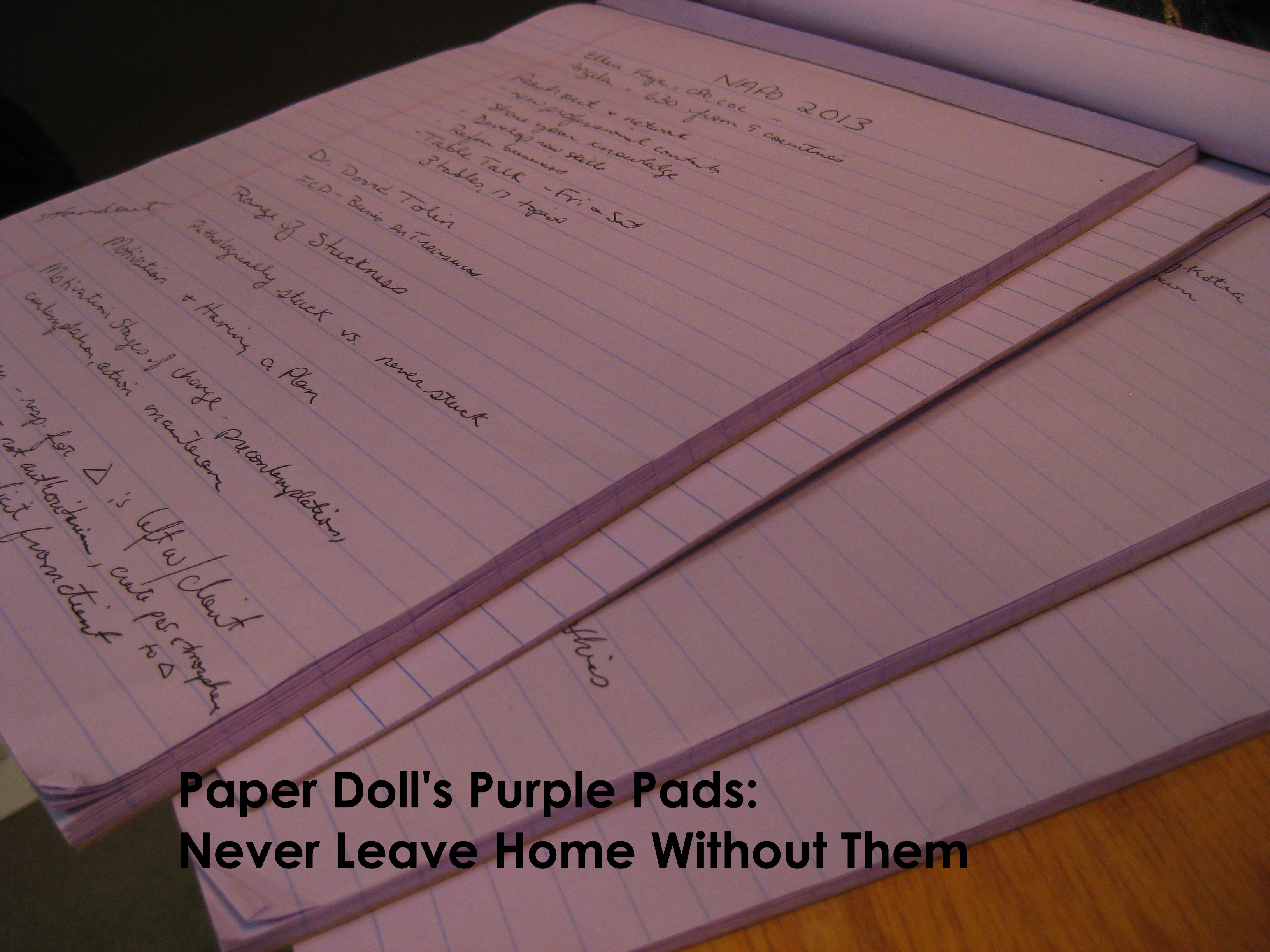
I’ve spoken before about my beloved purple legal pads. While I’m not helping the environment, the legal pads I use aren’t too fancy. I’m never afraid to mess up a page with a scribble, a splotch, or a stupid idea. The same isn’t true (for me, and for many people) when it comes to gorgeous, sumptuous notebooks.
Seven years ago, in Notions on Notebooks: Organize Your Paper Picks, I talked about some key points to consider when selecting notebooks: price (and branding), portability, binding, paper quality, lines (or dots, or graphs, or none), and color. I also pointed out:
CAVEAT: Over the years, I’ve had many clients who loved the sensory delights of fancy-schmancy notebooks: the colors, the materials, the bindings. They haunted bookstores and stationers and gift shops and bought them giddily, as if they were guilty pleasures. But they never used them. Why? For the same reason we save the “good” china for a special occasion and never wear that perfect outfit because the event doesn’t live up to the dream occasion we imagined when we bought it.
Could you dare write “broccoli, Lemon Pledge, dental floss” in a $52 leather-bound, crimson notebook? If not, either stick to manhandling those sexy notebooks in the stores (but skip buying them) or purchase notebooks with fancier covers but replaceable inner workings. Switch out the paper parts of the notebooks when you’ve filled them with brilliance or drivel, but keep your signature-style colors and fabrics on display as you desire.
Noteworthy Notebooks (Part 3): More Erasable & Reusable Notebooks Click To TweetSo, perhaps, the erasable Rocketbook and Wipebook notebooks we discussed last week offer that solution, an opportunity to create temporarily without fear of sullying a notebook. While last week we covered the big names in erasable, reusable notebooks, there’s too much of a bounty not to discuss other options.
SORA REUSABLE PLANNER
SORA, created by the Toronto-based IPPINKA team of designers, is a multi-sectional, customizable, reusable planner that features removable whiteboard pages. Like many of the modern products in Paper Doll’s Noteworthy Notebook series, SORA began with crowdsourcing via a Kickstarter. Although the campaign only started in Fall 2020, SORA is already a star.
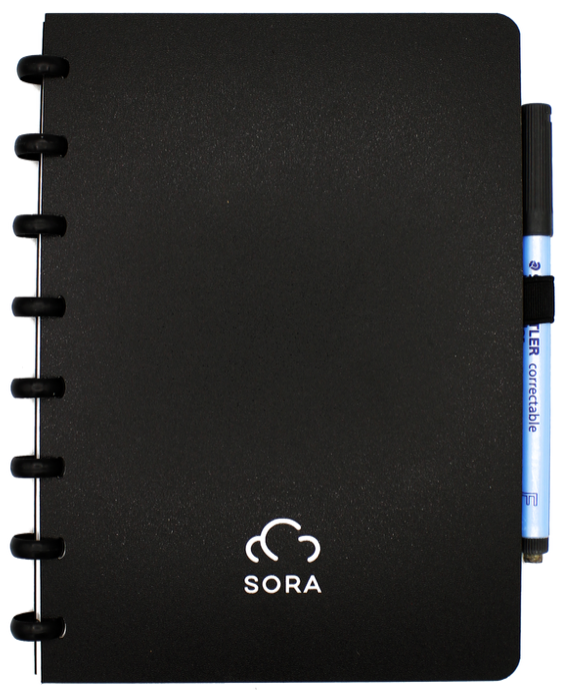
Note merely a blank notebook, SORA was designed to work as a planner to help improve and simplify professional and personal life with “whiteboard pages that stimulate goal-oriented and idea-driven scheduling over and over again.”
Each notebook comes with one Staedtler Lumocolor® correctable 305 F Dry Erase Pen in black, which can be erased using the pen’s built-in eraser, a tissue and a little bit of pressure, a damp cloth, or EXPO whiteboard cleaner. (So, unlike last week’s discussion, no microwave oven is necessary!)
SORA is formatted as an A5 (UK/European) notebook measuring 8.27″ x 5.83″. Its thin, flexible pages mimic traditional paper, and the notebook comes with 30 erasable whiteboard planner and tracker pages:
- Yearly Planner – This erasable planner lets you see your entire year so you can plan well in advance. The planner is undated for maximum flexibility.
- Two Monthly Planners – Two erasable planner spreads enable you to plan both the current and upcoming month, viewing recent past accomplishments and planning going forward. These planners are undated.
- Weekly Planners – Two erasable, undated, weekly planner spreads let you envision and organize essential events and tasks for the current and forthcoming week.
- Wellness Trackers – SORA’s two wellness tracker pages let you select two different health and fitness goals to improve. More water and more steps? More cardio sessions and a greater variety of vegetables? Strength training sessions and meditation? You pick!
- Habits Trackers – With five habit trackers, SORA help you track your professional and personal habits and make sure that you “don’t break the chain.”
- Blank, Lined, Dot-Grid Pages – It’s not really a notebook unless there’s a place to write and draw, so SORA includes 6 pages each of blank, lined, and dot-grid pages.
[Paper Doll’s suggestion: I’d prefer three weekly and monthly planner spreads to allow you to refer to the prior, current, and upcoming weeks and months so you could flip forward and backward.]
Aside from erasability, the key feature of SORA is that the arrangement of the pages is completely customizable, so you can rearrange the pages to suit your needs.
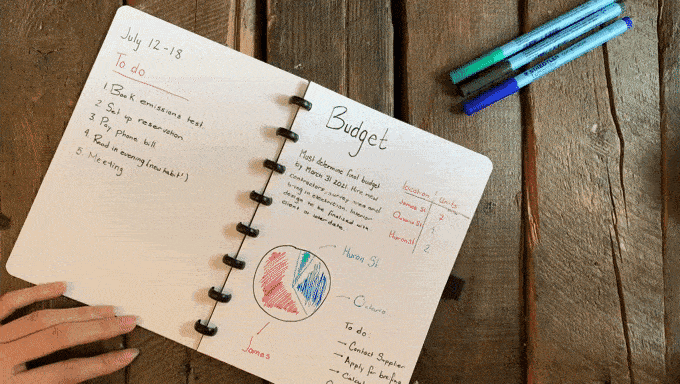
SORA uses eight 16mm binding discs, similar to what we saw when we discussed customizable notebooks like the Ampad Versa Crossover and the Sorta. So, instead of perforated notepad pages you can only use once, twist-prone wire binding, or loose sheets bound in bulky three-ring binders, SORA’s disc system lets you use the notebook open, or folded back on itself at any page to minimize desk space used.
SORA’s pages are waterproof and smudge-proof, so the notes won’t smush or accidentally erase like a typical dry-erase marker would.
The individual pages are removable, so they are camera-ready if you want to scan your pages and upload them to your preferred cloud service. (Unlike the notebooks we discussed last week, SORA doesn’t have a proprietary app.)
You can purchase a SORA notebook planner for $34 directly from the official site.
nuka ETERNAL STATIONERY
Ukrainian creators Katya Michalko and Nikita Vladykin, aged 17, joined by Eugene Shylo, aged 20, developed something novel with nuka Eternal Stationery. Rather than creating yet another whiteboard notebook with an erasable pen, they went back to basics and invented a better pencil and paper!
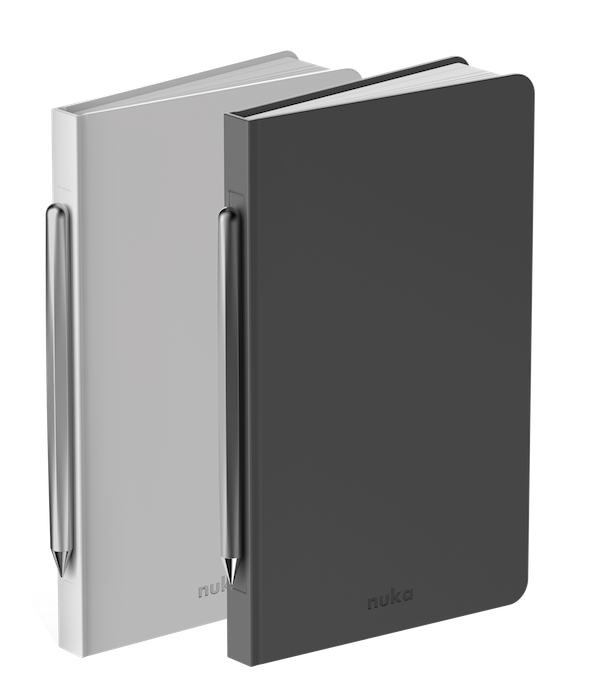
It all started with, you guessed it, a crowdfunding campaign. They began last spring, and though the community embraced their little vision quickly, everything from COVID to Chinese New Year to international manufacturing kerfuffles slowed down the process. But funders received their orders in April 2021, and soon the nuka Eternal Stationery (AKA: notebook) will soon be available for traditional purchase, too.
Let’s start with the nuka pencil. This is not your Grandpa’s old #2. The nuka pencil seems like an ordinary pencil, but it never needs to be sharpened and there are no inserts like with a mechanical pencil.
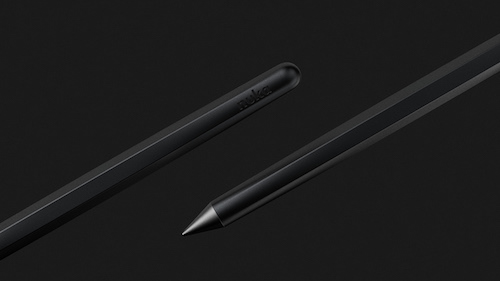
Instead, the six-inch nuka pencil writes with a metal alloy tip which oxidizes polypropylene paper. According to the nuka team, this technology makes pencil inkless (but also, y’know, graphite-less), eliminating any concern of about ink blobs, smudged writing, or wearing what you’ve written on your cuff or the sides of your hands.
Oh, and the pencil is magnetic. That’ll be important a bit later.
Next, there are 96 sheets of “virtually indestructible” paper in the 8″ x 5″ notebook. The paper is water-resistant and sturdy. You can’t tear it, and you definitely won’t rough it up by erasing too hard. And yes, you can erase the pages.
Although the team hasn’t explained how they’ve done it, or what by secret process they’ve developed it, the pages are waterproof, so even if tiny humans (or furry friends) spill all of your coffee onto your notebook, you needn’t fear losing your million dollar idea or key dialogue for your novel. Your writing also won’t fade over time. All the team has said (and remember, Ukrainian is their first language) is, “We don’t use traditional materials as timber neither for notebook, nor pencil. That definitely helps to save our planet resources.”
But nuka IS a rewritable notebook. Erase small portions with any ordinary eraser, but you can eliminate a whole page by wiping it with a bit of hand sanitizer. (Given the past year, you probably have a LOT of that!)
Although you should use the pencil, the nuka team did research how other writing implements interact, and they report, “Out of the 200 writing instruments we used to test the notebook’s ability to be wiped off, only two types of instruments proved to be difficult; gel pens and permanent markers. While you can use these instruments on the notebook, you might not be able to remove them at all afterwards.”
The silicone cover over the bound pages of the notebook has space for a magnet in the spine, so you’ll never lose your fancy-pants nuka pencil because it’s always attached to the notebook! (Just don’t take it into an MRI machine!)
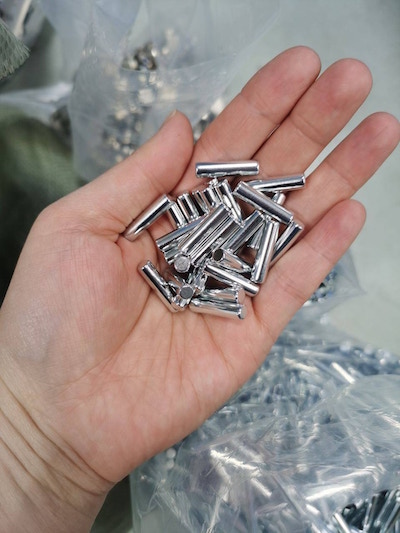
Finally, there’s the forthcoming nuka app to help you digitize and synchronize your notes across any smart devices so that even when your notebook isn’t at hand, or after you’ve erased something previously uploaded, your works of genius can be retrieved from the cloud.
The combination nuka eternal stationery (notebook and pen) sold for $69 during the crowdfunding stage; watch their social media to see when it’s available for traditional purchase. (And watch this video. It’s fun!)
INFINITY NOTEBOOKS
For something a little more down to earth, there’s the Canadian Infinity Notebooks.
First, Infinity Notebooks are durable. The pages are made from a long-lasting polyester paper. The company claims the covers and the pages are highly tear-resistant and completely waterproof, and pages are designed to be added or removed “thousands of times” without damage.
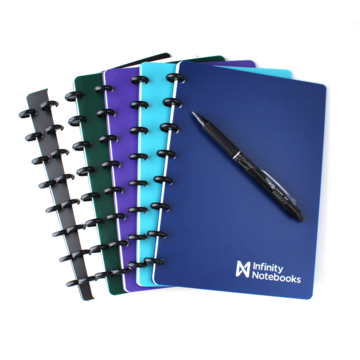
Next, like everything in this category, the notebooks are reusable. Write or draw in your Infinity Notebook using any of the following supported writing utensils:
• Pilot FriXion Pens (You’ll recall these from the last post.)
• Uniball R:E Pens
• Pilot FriXion Highlighters (Wait, did you know there were erasable highlighters?)
• Pilot FriXion Stamps (Like fun little analog emoji for erasable notebooks.)
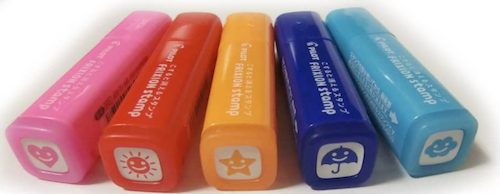
[The website notes that: Pilot FriXion Markers can also be used with the Infinity Notebook, and while they erase well, they are not recommended because the ink takes longer to dry and is prone to smudging.]
Whichever of the supported writing/marking solutions you choose, the ink will bond with the paper to stay put, but will erase cleanly with a damp cloth or paper towel. You can also use the eraser that comes with the pens, which lets you make small, incremental corrections without risking erasing a larger area of your work.
Next, Infinity Notebooks are customizable. We’ll be talking more about customizable notebooks next time, but, like the SORA described above, the Infinity Notebooks use disc binding so that you can add, remove, or move pages or sections to wherever you want.
You can also swap covers and pages, so while you only have to carry one notebook to class, you could return to your desk and move each class’s notes to one dedicated to a specific course. Or, you can just designate different sections of your notebook for planning and goal-setting, journaling, task lists, etc., and move pages accordingly.
In addition, because Infinity Notebooks are compatible with most popular discbound systems, you can use accessories and features from other product lines, like planners, trackers, calendars, sticky notes, tape flags, and more. (The company also plans on expanding its own line of discbound products to accessorize the Infinity Notebooks.)
Currently, the Infinity Notebook only comes in Executive size, measuring 8.5″ x 6″. There are six choices of colors for the poly covers: Par Blue, Black, Azure, Forest, Purple, and White.
Each notebook includes eight black binding discs, the two poly covers, 30 ruled pages (15 sheets), 6 checklist pages (3 sheets) and 4 mini checklist pages (2 sheets). Each also comes with one Pilot FriXion pen and use and care instructions.
The Infinity Notebook is $36 on the website; packs of 5 additional pages (in either ruled, checklist, or mini-checklist) are $7.99. They also sell the fun Frixion stamps, imported from Japan, for $3.99 each.
(HOMESTEC/GUYUCOM/NEWYES) SMART NOTEBOOK
Maybe you want to explore erasable notebooks at a lower price point, in case you don’t like the experience?
I’ve found that three different companies are marketing the same “Smart Notebook,” with identical marketing copy (complete with the same grammatical quirks) so whether it’s Homestec, Guyucom, or NEWYES, you’ll find the same product, available in five different sizes, for between $10 and $14. In fact, if you look at the Amazon page for the Standard B5 (UK/EURO sizing)/6.9″ x 9.8″ version of the Homestec Reusable Smart Notebook and scroll down to the graphics that compare the other sizes, you’ll see NEWYes referred to in the chart.
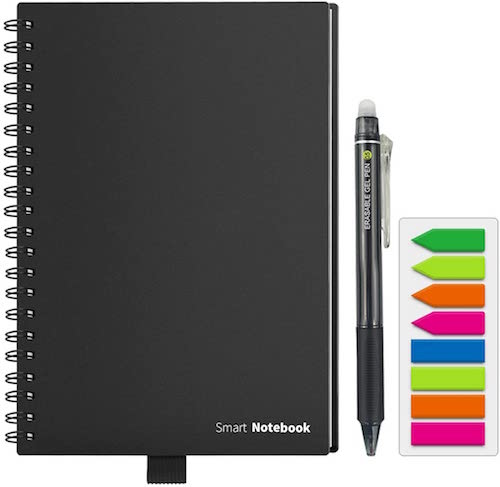
There’s no reference to what, if anything, makes the paper special, which makes me wonder if it’s just standard paper. It simply references using NEWYES erasable pens, for which you should allow 15 seconds for the ink to dry, after which you can erase using the eraser that comes with your erasable pen, a damp cloth, or a hot hair dryer! (Well, at least it’s not another microwave oven!)
After writing and before erasing, they recommend downloading and using either of two apps, the NEWYES Note or CamScanner, to send notes to Google Drive, Dropbox, Evernote, Box, OneNote, iCloud, and email, either as PDFs or jpegs.
The marketing copy claims that each notebook can be reused over 500 times. Interestingly, these warn not to use your notebook in the sun or when it’s above 140° F/60° C (yikes!), or the ink may disappear.
Why do I get the sense that this will become some kind of reverse-invisible-ink plotline on a sitcom?
This version of the notebook has a black cover with wire-O binding and comes with 7 planning pages, 30 lined pages, and 30 dot-grid pages, as well as one NEWYES-branded erasable pen, and a set of colorful adhesive indexing tape flags for bookmarking or noting important pages, all for $13.58.
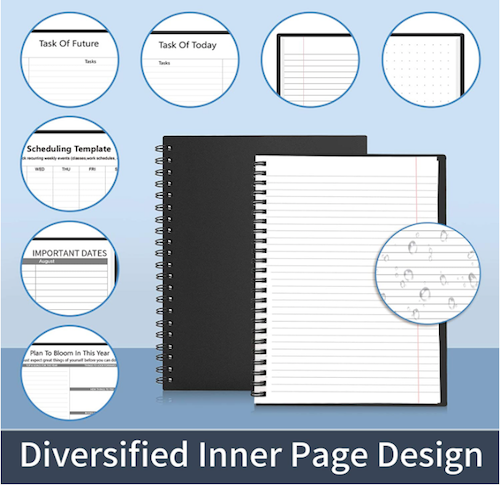
There are three other main sizes of the SMART notebook (no matter the branding):
- Letter Size (11.2″ x 8.7″) with a black or navy blue cover, 2 NEWYES reusable pens, and 1 set ofcolorful adhesive indexing tape flags
- Notebook Memo Size (6.7″ x 4.2″) with a black cover, 1 NEWYES reusable pen, and 1 set of colorful adhesive indexing tape flags
- Notebook “Standard” Size A5 (9.1″ x 6.9″) with a black cover, 1 NEWYES reusable pen, and 1 set of colorful adhesive indexing tape flags
All of the above versions are designed primarily for notetaking; there’s also an A6 (6.7″ x 4.2″) sketchpad version with 40 lined pages and 40 dot-grid pages for $11.88.
All blogs and videos I’ve found reference that you can replace the NEWYES pen with a Pilot FriXion erasable pen.
OUTLIERS NOTEBOOK
Finally, after reviewing many erasable notebook options, I came across, well, an outlier. In fact, the Outliers Notebook. The web site says that the design team formed in United States, but all of the employees are in Turkey; the headquarters in Delaware is a virtual office but all the prices are in Euros.
The notebooks come in three sizes: Executive and Standard Outliers notebooks both measure 8.66″ x 5.9″, and the Pocket version is 5.5″ x 3.54″. The Executive comes with either a faux-leather or cloth cover, magnetic closure, and 224 pages of 80 gsm acid-free paper; in addition to blank or ruled options (you can’t mix them in one notebook), there’s an annual planner and habit and goal trackers.
The Standard Outliers version offers the same features as the Executive, but with a cloth cover. The Pocket version is only 191 pages, has an elastic closure. (It appears to have a cloth cover.) Cover colors include black, dark grey, light grey, red, navy, purple, light grey, orange, and green.

Each notebook comes with a proprietary Outliers pen.
Aaaaand because you knew there had to be one more, Outliers recommends erasing the notebook in a microwave oven. No microwave? That’s OK, they say; you can use your hair dryer. They also warn, “Notes on your Outliers Notebook disappear at 60°C and come back at -10°C. Unless you leave your notebook in environments that are either too cold or too hot for long periods of time, your notes will be safe and previously erased notes will not return.”
I’m thinking this will also show up in the sit-com!
However, taking us all the way back to the concerns about the original Rocketbook Wave we discussed last week, they say, “You can erase your notebook in the microwave for an indefinite number of times; however, the notebook should ideally be reused up to a maximum of 5 times due to natural wear and tear that may occur through usage.” So, it’s not super reusable, but just a little reusable!
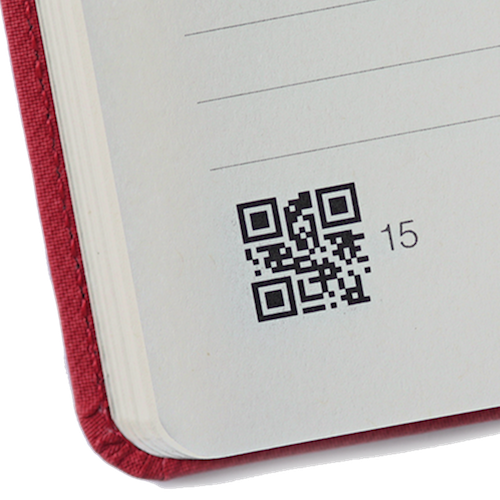
Each page of the Outliers notebook contains QR codes that indicate the page numbers. Outliers (iOS and Android) apps include QR code scanners, which read the QR codes, recognize page numbers and automatically index all your pages in the correct order as PDFs. Users can add keywords to digitized notes and search within the Outlier app, and of course, share via email or to cloud services.
Outliers claims superior image processing by augmenting the page resolution, stabilizing the brightness, and providing automatic perspective corrections by detecting the scanned page area, no matter the angles from which you shoot.
Outliers Notebooks can be purchased directly from their site, but again, please note that pricing is in Euros. The Executive versions are 28 and 26.5 Euros (faux leather and cloth versions), the Standard Outlier is 25 Euros, and the Pocket version is 18 Euros. (That’s about $34, $32.23, $30.40, and $21.88, respectively, as of the writing of this blog.) If any of our Paper Doll readers in the EU are up for sampling this option, please report back on your experience.
Next week, we’ll move on to a new category, notebooks you can customize and truly make your own. Until then, if you’ve missed anything, you can catch up at:
Noteworthy Notebooks (Part 1): Re-Surveying the Landscape
Noteworthy Notebooks (Part 2): The Big Names in Erasable Notebooks
Noteworthy Notebooks (Part 2): The Big Names in Erasable Notebooks
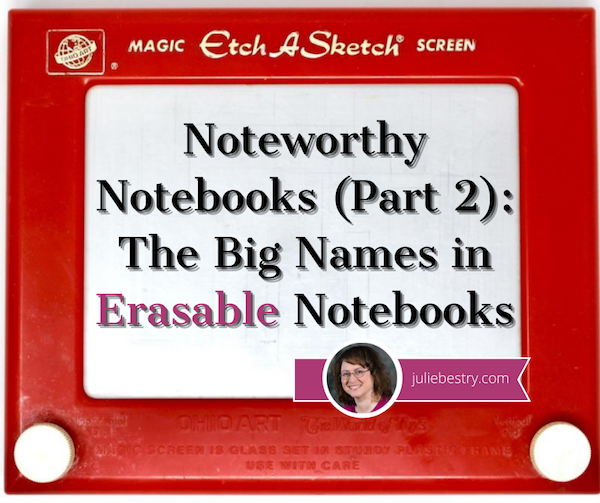
CHILD’S PLAY
Do you remember the Etch A Sketch? Invented 61 years ago, the iconic red tablet (long before iPads) was shaped to look a bit like a flat-screen TV (long before flat-screen TVs), but required no electricity, batteries, or WiFi (which is good, because the internet hadn’t been invented yet, either). By turning the horizontal and vertical knobs (designed to look like old-time TV knobs) you could create words. (Sorta.) You could make art!
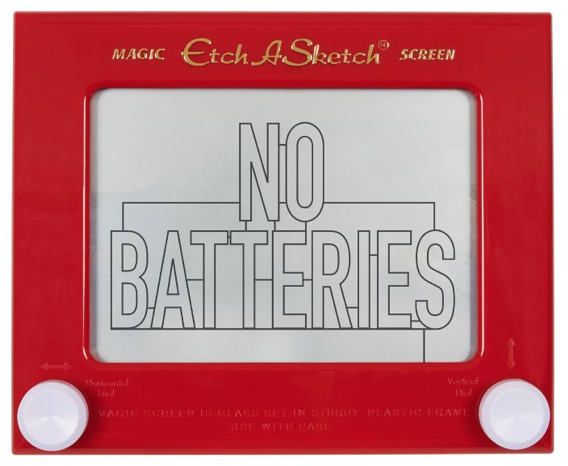
Granted, most of it didn’t look particularly artistic, but you got to be creative, and when you were done and ready to create a new masterpiece, you just shook the entire Etch A Sketch and the whole screen was erased, and you could start fresh. (If only life worked that way!)
There was another toy, less iconic, but no less common. You may not know the name Magic Slate, but I bet you had one. As it dates back to the 1920s, I bet your grandparents even had one! On top of a stiff cardboard backing, there was a black slate, and atop that, a sheet of plastic. Using a stylus, you could draw or write; to erase, just lift up the sheet of plastic, and your Magic Slate was ready for you to start anew.
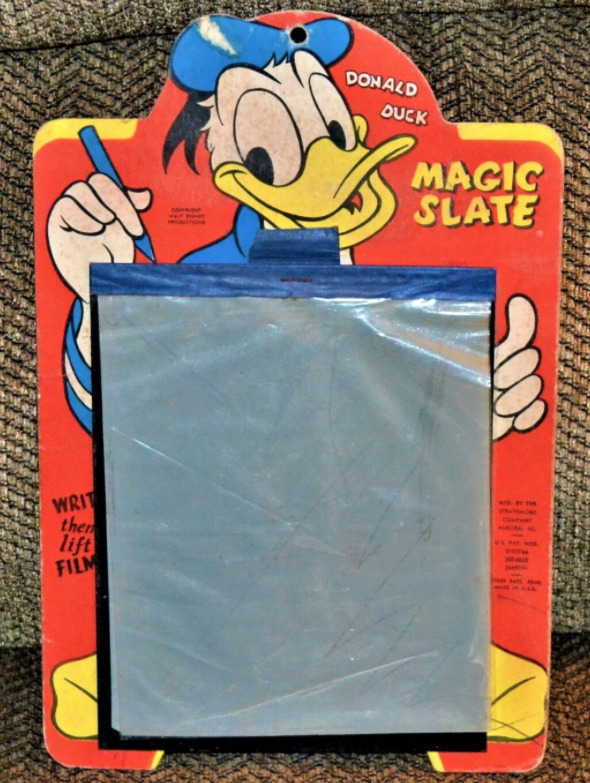
A few years ago, some savvy designers realized that while we like all of the features of computers, tablets, cell phones, and the internet, we also really like to write and draw by hand. And while the newest tablets offer some of those features, writing and drawing on glass just doesn’t feel the same as drawing on paper.
So, one after another, a series of designers came up with notebooks that are somewhat (more or less, depending on the product) like writing or drawing on paper, but you can erase what you’ve created.
No, you don’t have to write in pencil (and fill your desk with erasure crumbles). And yes, you can retain your content and still use your notebooks over and over. And you can be gentle to the environment by not requiring whole forests to be cut down. The natural grandchild of the Etch A Sketch and Magic Screen are erasable notebooks.
ROCKETBOOK
If the Etch A Sketch represented the early and mid-20th century, Rocketbook‘s wide variety of fancy-schmancy, modern, erasable, reusable notebooks are the future. (In fact, when Rocketbook went on the TV show Shark Tank, they described their products as they do in all their videos, explaining that they make “notebooks for the future” with sustainability in mind.)
The initial Rocketbook was the Wave, a crowdfunded spiral-bound notebook that appeared on the scene in 2015. You could write on the pages with any of the colorful Pilot FriXion erasable pens, and fill every page, edge-to-edge and top-to-bottom.
Once your notebook was full, instead of buying a new one, as you’d do with paper notebooks, you could capture the contents of the Wave by scanning it with the special Rocketbook app. Tiny icons at the bottom of each page directed the app to send your creations to the cloud, and specifically to the right service in the cloud, like Dropbox, Google Drive, Evernote, OneNote, or even to email. Done scanning? You’d just erase the contents by putting the Wave in the microwave.
Yes, in the microwave. (Hence the Rocketbook Wave.) When the logo on the cover turned from blue to white, you knew the notebook was erased.
Weird. I mean, everyone thought that was weird. I had a small microwave oven, and the first time I saw the notebook, I realized that while the Wave would fit inside my microwave, the design would make it hard to get INTO my microwave without rolling or folding it. Plus, I had some serious hygiene concerns with putting something one carted around all day into the same device where I cooked my food. (OK, where I boiled water and made popcorn, but still…)
Also, each of the notebook’s 80 pages could be erased only five times. FIVE times? I tried to recall how many pages of transcription-like notes I took in college classes, how many pages of notes I take during a client session, and how many I write in almost any educational setting. At that rate, I’d be buying new Waves every month or two. That might be sustainable for the rainforests, but not for me!
Bit by bit, people embraced Rocketbook’s Wave, and I enjoyed seeing it up-close at NAPO conferences when my colleagues would take notes, but my love for the environment and for gadgets was not as profound as my love for keeping food and non-food things in separate realms, and my dismay over the limited number of uses.
(I also wish I’d asked where they were finding microwave ovens at the conference hotel; I take almost a full legal pad of notes during a three-day conference. Were they uploading, erasing, and starting over every day? Inquiring minds…)
Rocketbook, however, wasn’t worried about naysayers like Paper Doll, and continued to expand the product line and make some of the most goofily entertaining office supply promotional videos on the market. As they went along, everything they invented with their accent on creating notebooks “for the future” focused on four key attributes of their products: write, scan, share, reuse:

Next came Rocketbook Everlast, which was later renamed Core, as it serves as the core of the Rocketbook lineup. The pages of the spiral notebook were created from a polyester composite rather than wood, but still felt like paper, and while marks made with the Pilot FriXion erasable pens would stay smudge-free, entire pages could be erased with the wipe of a damp cloth. The Core is “infinitely” erasable, they say, and while I’m not sure anyone can test that claim, infinity is definitely a higher number than five.
As with the original Wave, the Rocketbook app lets you scan the page using the QR code at the bottom, and whichever of the tiny icons you select will direct the app to send your work to be stored at the right cloud storage site. iCloud, Slack, and Box were added to the original options.
Note: the icons on the bottom page are generic: Rocketbook’s logo, diamond, apple, bell, shamrock, star and horseshoe. You configure each icon to link to whichever service you prefer, so as Rocketbook’s integrations grow, so do your options.
Another cool features: if you hand-write hashtags (# marks) around the title of your page at the top, it will transcribe your handwritten note as text to create as the title of the document.
The Rocketbook universe (see what I did there?) continues to expand. Among the erasable notebooks, there are:
- Wave, the original Rocketbook, comes in two sizes, Standard (8.5″ x 9.5″) and Executive Size: (6″ x 8.9″), each with 80 dot-grid pages on acid-free, fine-grain paper, with a blue cover. The left-side spiral binding is polypropylene. Each page can be erased five times by microwaving. $27 for the Standard, $25 for the Executive, directly from Rocketbook, or $21 for the Standard and $27 for the Executive at Amazon.
- Core (formerly Everlast), comes in two sizes, Letter (8.5″ x 11″ with 32 pages) and Executive (6″ x 8.9″ with 36 pages) in either dot-grid or lined formats. The covers come in eight colors: Infinity Black, Atomic Red, Midnight Blue, Neptune Teal, Beacons Orange, Deep Space Grey, Terrestrial Green, and Scarlet Sky, and the left-side spiral binding is polypropylene. A microfiber cloth is included, and all pages can be erased by wiping with a damp cloth. The Letter size is $34 and the Executive is $32 at Rocketbook, or for $28 and $24, respectively, on Amazon.
- Fusion looks like the Core from the outside, coming in the Letter and Executive sizes, with the same eight cover color options and connects to the same cloud services. But Fusion takes the Rocketbook a step beyond with formatting . The 42-page Fusion uses seven different page templates: task list, weekly planner, monthly calendar, idea list, plain, lined and dot-grid pages, and an ORK goal template (with space for objectives, key results, an action plan, and reflections). The Letter size is $37 and the Executive is $35 at Rocketbook with similar pricing at Amazon.
- Panda Planner is a Rocketbook extension of the popular Panda Planner line of happiness-inspiring personal planners. The exterior features are similar to the Core (though it’s only available in Infinity Black, Neptune Teal, Midnight Blue, and Scarlet Sky), and it comes in Letter (32 pages) and Executive (36 pages) sizes. Instead of the Rocketbook logo, the Rocketbook Panda Planners bear the panda head logo. Pages include undated monthly, weekly, and daily templates to organize your tasks and appointments, and goal and motivation templates for “building happiness.” Like the Fusion, the Rocketbook Panda Planner is priced at $37 for the Letter size and $35 for the Executive, at both Rocketbook and Amazon.
- Matrix comes in only one format, the 32-page Letter size (8.5″ x 11″) with cover colors including Infinity Black, Midnight Blue, Neptune Teal, Deep Space Grey, Terrestrial Green, and Scarlet Sky. Instead of dot-grid or lined, the Matrix uses a graph pattern specifically designed for STEM classes and technical note-taking. In addition to 30 graph pattern pages, the Matrix includes a scientific index page to track and improve organization, imperial and metric rulers for field measurements, and a place to label the 1/4” square units. The Matrix runs $24 at Rocketbook and on Amazon. (There’s no word as to whether Neo and Morpheus will help you with your STEM homework in the Matrix. I suspect that will cost extra.)
All of the versions of the Rocketbook referenced so far have the spiral binding on the left side. Although Rocketbook has not (yet) created any landscape formatted notebooks, they offer two options with the spiral binding at the top:
- Rocketbook Flip is billed as “the galaxy’s first ambidextrous notebook,” and it’s definitely a boon to lefties with the spiral running along the top. The covers come in Infinity Black, Midnight Blue, Neptune Teal, Deep Space Grey, Terrestrial Green, and Scarlet Sky, and the pages themselves do double-duty, as each page is formatted with lines on the front and a dot-grid on the back. (A version with blank pages is also available.) Like the Core, it comes in Letter (8.5″ x 11″ with 32 pages) and Executive (6″ x 8.9″ with 36 pages) and runs $34 for Letter and $32 for Executive at Rocketbook and $30 and $27, respectively, on Amazon.
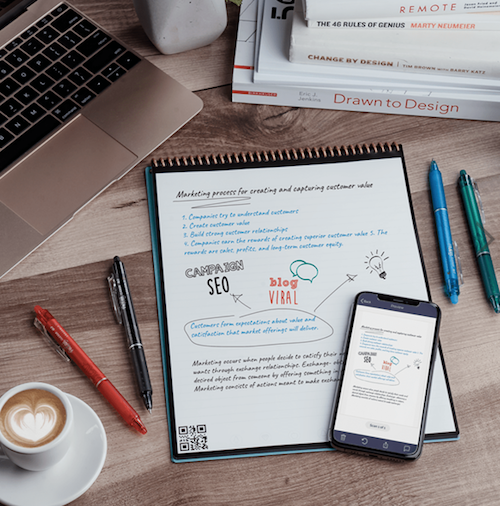
- Rocketbook Mini takes the Flip and shrinks it down to 3.5″ x 5.5″ to fit easily in a purse or pocket. As with the Flip, the spiral binding runs across the top, and the cover comes in Infinity Black, Midnight Blue, Neptune Teal, Deep Space Grey, Terrestrial Green, and Scarlet Sky. The Mini is 48 dot-grid pages, and costs $16 at Rocketbook and a little less on Amazon.
All versions of the Rockebook come up a Pilot FriXion erasable pen, and all versions except the Wave come with a grey microfiber cloth.
And now, there’s a new product on the horizon, the Axis, which has just completed its Kickstarter campaign. Because the Axis has some special features beyond reusability, we’ll be returning to it in a few weeks when we cover customizable notebooks.
While Rocketbook is the biggest name in erasable notebooks, it’s definitely not alone.
WIPEBOOK
Wipebook imagines its products as a blending of traditional notebooks with whiteboards, but instead of using erasable pens, Wipebook’s works with either correctable markers or dry-erase markers. But we’ll get to that in a moment.
Instead of focusing on notetaking, we’re supposed to consider Wipebook notebooks as the ultimate reusable whiteboard notebook for brainstorming on-the-go. You can write or draw, make temporary notes and squiggles, and then erase without wasting paper. In fact, they have a nice little motto: “Go ahead and make a mistake. Nothing should be permanent.” To that end, they’ve upgraded their pages to a new hypergloss film designed to make erasing and reusing an even smoother process.
Every Wipebook contains 32 graph, ruled or blank 8 1/2″ x 11″ pages. The ruled notebook has a green cover; the graph version’s cover is blue, and the one with blank pages is red. There’s nothing fancy to look at, but the focus is on the use.
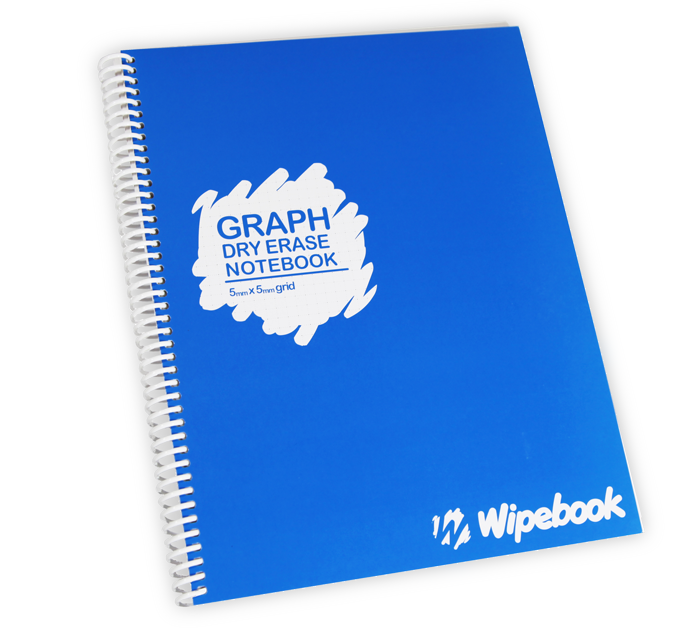
Depending on the longevity you need for your doodles and masterpieces, Wipebook recommends two options. First, they like Staedtler Lumocolor correctable markers as they won’t smudge on the hypergloss pages, but the ink can be removed with the integrated erasers (for a small area) or a dry cloth, either when you’re finished, or to correct mistakes. They come in two styles, fine and medium tip, and unlike traditional dry-erase markers (which you can also use), they provide a more semi-permanent solution.
Noteworthy Notebooks (Part 1): Re-Surveying the Landscape
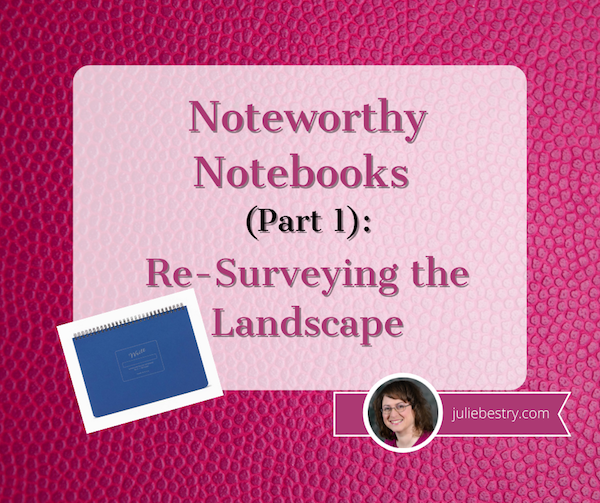
Portrait vs. Landscape. Vertical vs. Horizontal. Uppy-downy vs. sidey-sidey. While most aspects of organizing are equal opportunity, paper organizing products tend to take sides.
For example, when it comes to most of the paper filing topics we discuss here at Paper Doll HQ, the horizontal view is the norm. Think tabbed folders, hanging files, filing cabinet drawers. Certainly, we look at a lot of vertical organizing solutions at the macro level, but while we file vertically, the products, themselves, generally have a horizontal, or landscape layout.
It’s a real rarity when we look at vertical filing solutions; in fact, we haven’t done it since New Smead Organized-Up Folders Stand At Attention in 2013! (Moreover, other than the main Smead products reviewed, the other items referenced in that post have gone the way of the dodo!)
Conversely, when we talk about organizing our actual writing, it’s the portrait, vertical, uppy-downy approach that gets most of the love. That’s why my 2014 off-ramp post Surveying the Landscape: Around the World with Horizontal Office Supplies was so unusual. I had to hunt for non-filing related paper products in a landscape-orientation.
Indeed, almost every office supply in that post is a riff on a clipboard, and even then, many of the options were only available in Europe and Asia. (Granted, there were some really cool products in that post, like the waterproof clipboard that created a little raincoat to let you keep your papers collected and dry in inclement weather.)
The only thing close to a notebook I found to include in that post was Roaring Spring’s line of 11″ x 9.5″ landscape notepads (available in multiple colors of lined or white graph format).
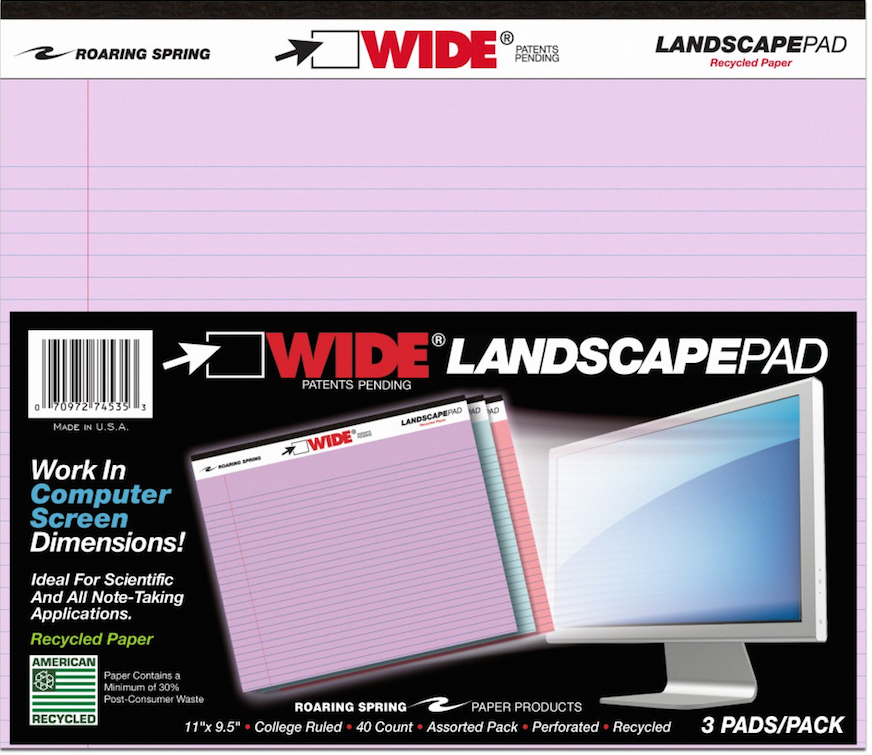
A year later, in 2015, I finally dug deep (or shall I say, wide?) into the topic of landscape-orientation notebooks and notepads in Paper Doll Surveys the (Paper) Landscape, where again, those Roaring Spring notepads took center stage. Beyond those and some special prototyping notebooks for web designers, all I found was a notebook sold in Japan with German marketing copy and the Rhodia Webnotebook sketching journal.
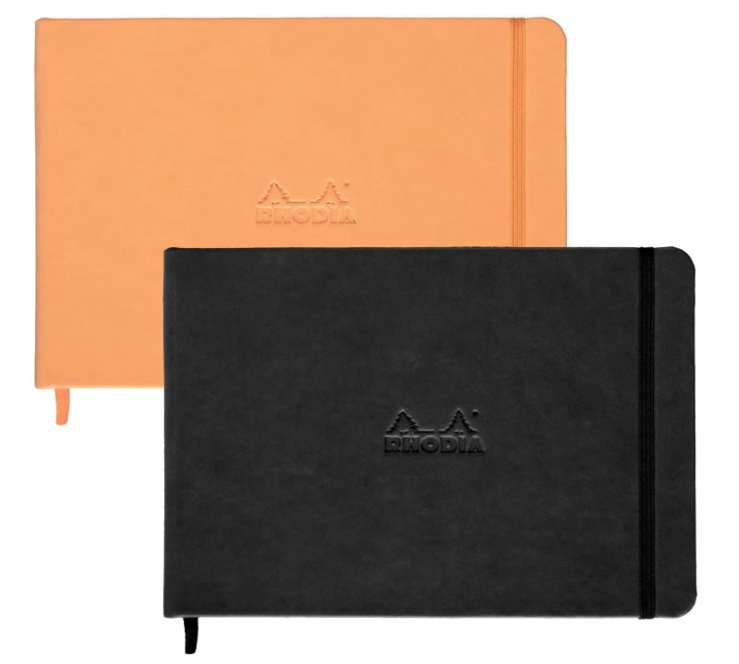
Even then, landscape is seen as primarily for creating landscapes – for drawing, designing, sketching.
At the time, I tried to explain why I thought landscape notebooks were important. (Imagine that I’ve inserted one of those wiggly sit-com flash-back effects here.)
OK, Landscape. But Why?
Most of the time, when we hand-write, we are in portrait mode, and it usually makes sense. However, I can think of a sampling of reasons why we might want to have some side-to-side breathing room.
Most notebooks are portrait, but a landscape orientation has six significant advantages: for notetaking, ergonomics, room for expansive thought, to do mind-mapping and flow charts, and to emulate TV/computer screen dimensions. Click To Tweet1) Notetaking – When we’re taking notes in a committee meeting or for class, we’re often creating a linear, outline-style set of notes. But, as we discussed when we reviewed the exceptional Cornell Notetaking Method, we need to make room for cues or other special attention-getting markings on the left side.
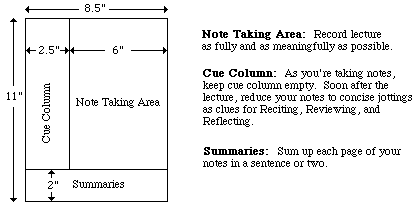
With traditional 8.5″ wide paper, that either reduces our notetaking space or forces us to write in the narrow margin, making it more likely that we’ll get inky smudges on that all-important cue-section. Landscape orientation provides more breathing room.
2) Ergonomics – Look at the available space on and around your desk. If your computer is in front of you, your keyboard is probably somewhere between elbow-and-wrist distance away, not leaving you very much space for alternating typed notes and handwritten notes. Because of that limited space, you may find you’re turning your traditional (portrait-orientation) notepad sideways, with the top to your left (unless you’re a southpaw). This lets you take written notes, but you’re probably twisting at the waist to do so. This is not sustainable or ergonomically friendly.
3) Expansive thought – When we take notes, journal, free-write, or craft letters, we’re often thinking linearly. It’s easy to follow a unidirectional flow of ideas, or paths, with a narrower piece of paper. When we’re on the computer, using Microsoft Word or any other word processing program, unless we’re using design features for creating signs or brochures, we echo that same tall/narrow format.
But what happens when we want to think more broadly (no pun intended)? When we’re on the computer, using a spreadsheet like Excel, we create multiple columns so that we can visualize information best seen side-by-side, like multiple fields in a record. But what’s the paper version? I can think of a number of times when I’ve been working with a client to brainstorm ideas in parallel (like how different departments will handle particular situations), and we end up turning a notepad sideways. The lines go the wrong way, and the content gets messy; it suffices, but it’s not optimum.
4) Mind mapping – Paper Doll is a fairly linear thinker, but when I’m trying to mind-map, or show the relationship between different processes, or do anything that’s more visual, I need more space. With some clients, we may choose mind mapping software or apps like MindNode or XMind, but we often find that an analog solution is faster and more immediate. Most often, we end up using multiple Post-It! Notes on a wall or window. That’s great when we’re in a house or office, but not so optimal when we’re in the field (even in a field), in a warehouse, or going mobile. That’s where these landscape notepads (and the aforementioned landscape clipboards) really come into their own.
5) Flow Charts – It might not be immediately apparent, but a number of law students have posted online comments regarding how landscape writing pads make it easier to visualize case-law timelines, precedents, and conceptual flow. Scientists have also reported that wide-format paper helps conceptualize scientific reactions more clearly.
6) Computer/TV Screen Dimensions – Tablets and phones aside, we spend a lot of time looking at screens in landscape orientation, and sometimes we still need to make our analog notes approximate what we’re seeing, or make our digital notes approximate what we’d like to be seeing on the screen. Writing pads that parallel those dimensions are helpful.
So, What’s New on the Landscape Landscape?
If, other than sketchbooks, it was hard to find a landscape notebook six and seven years ago, how do you think it’s going now for those who want to apply a wide-angle lens to their analog writing?
PANOBOOK
Well, newer on the topic is the Panobook, which I discussed in 2019 in Organizing the Shape of Notebooks to Come: Panobook, Triangle, and Sidekick as part of a look at oddly-shaped notebooks. It works for all of the reasons listed above, but particularly with regard to fitting nicely between your body and the keyboard.
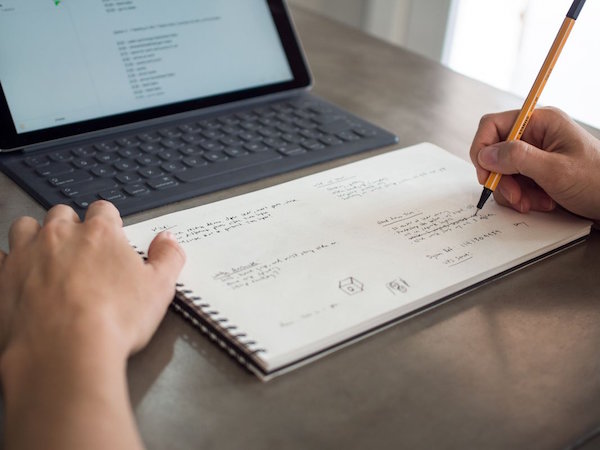
At the time, I noted the difficulty of using your computer and a notebook at the same time, especially when space is at a premium:
If you want to take notes, maybe you can scroll (I mean, slide) your body to the left or right, or you may have to swivel in your seat to use the left side of the desk (or the right side, if you’re left-handed) to take notes. Unless your arms are long (and your eyesight so pristine that your monitor is very far away), there’s just not that much writing space in front of you. (And I’m pretty sure you don’t want a notebook poking into your tummy.)
Panobook measures 160 mm x 288 mm (6.53″ x 11.34″) and is designed to sit squarely in front of your keyboard. It’s made of high-quality (70 lb) paper and meant to perform with a variety of writing instruments and inks without causing bleed-through or smudging.
The front and back covers of Panobook are made of rigid black chipboard, and the whole thing is bound with sturdy black Wire-O (AKA: Twin Loop) spirals measuring 12.7 mm (0.5″) in diameter, so the Panobook sits flat when opened without the cover smacking back into place or bending, as you get with perfect bound notebooks or glued notepads.
Each notebook contains 50 sheets (100 pages). Neither blank nor lined, the Panobook has a subtle dot pattern with grid spacing at 5 mm (0.20″), so you can use it for writing, drawing, or laying out charts. For web interface design or storyboarding, there are guide markers to aid in drawing three rectangles on the page, and edge guides to divide each page and provide cues for layout.
Each Panobook comes with a slip case to make it easy to label the spines with the notebook’s content and start and end dates so you can catalog them together on a shelf.
Panobook is available directly from Studio Neat for $20/notebook for one or two; they’re discounted to $19/notebook when you purchase three to eleven, or to $18 if you buy a dozen.
BetterBook
In June 2020, a group of young designers from Amsterdam called orangered life teamed up and launched BetterBook, a landscape notebook campaign on Kickstarter that really got the attention of the crowdsourcing, uh, crowd. (It successfully moved to IndieGogo for expansion.)
Used to sharing their ideas by passing around their notebooks in the office, they needed a better pandemic-friendly solution as they worked from home, still designing with analog notebooks.
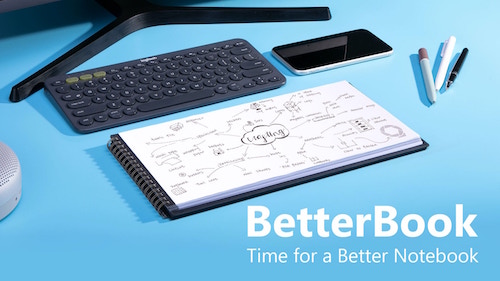
The orangered life team saw their BetterBook creation as having four distinct advantages over the typical notebook:
- Content is sharable – The BetterBook is an analog notebook, but the team figured out how to improve digital capturing and scanning. Each page of the notebook had a 0.5 cm black border on the left and right sides; the notebook’s covers extend beyond the pages, creating a 1 cm border at the top and bottom of each page; the border frames each shot perfectly, so your phone or scanner apps can capture each scan quickly and easily without delays, mistakes, or kerfuffles. (I wish checks were designed this way; it would improve the mobile deposit process.) Create, point, shoot, share!
- Scanned images display better – Because the BetterBook uses an 18:9 ratio, the format matches both mobile phones and computer widescreen monitors perfectly. So, because captured images are designed to fit screens perfectly, there’s no letterboxing effect – no black borders on the top and bottom of the screen, and there’s no pinching and zooming necessary, which often causes a loss of finer details.
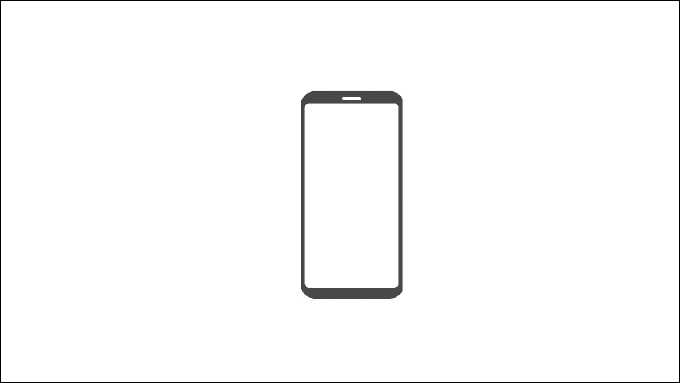
- It fits on your desk just below the keyboard – The Betterbook comes in two sizes: the Desk Notebook measures 310 mm (12.2″) x 160 mm (6.3″) and the Pocket Notebook (for when you’re back to working in coffee houses again) measures 130 mm (5.12″) x 70 mm (2.76″).
- There’s a built-in note organizating and time management doodad – In the bottom right corner of each page, there’s a subtle grey symbol designed to help you organize your work. The tiny spaces let you note deadlines, reference edits, or add anything you need to help categorize your important information.
The Betterbook has three acid-free, fine-grain paper options: blank, lined grid, or dotted grid. Both the Desk and Pocket sizes have 40 sheets (80 pages).
The BetterBook team sees its product serving designers, artists, (board/tabletop) gamers, and workers in creative industries. They also promote it for writers and students, though the lack of lines may make it difficult for some writers to get used to.
You can purchase BetterBook via Indigogo for $31 for one book or $79 for a set of three.
Write Notepads & Co.’s Landscape Notebook
Chris Rothe, a third-generation bookbinder at Baltimore-based Write Notepads & Co. has a plan to “make notebooks cool again.” (Paper Doll has always thought notebooks were cool. Paper Doll is unwilling to entertain the thought that not everyone thinks she’s cool.)
So, @WritePads wants to make notebooks cool again. Paper Doll has *always* thought notebooks were cool. (Paper Doll is unwilling to entertain the thought that not everyone thinks she's cool.) Click To TweetThe company makes a variety of deluxe notebooks – in the United States – using environmentally-friendly materials like vegetable-based inks and premium cover stocks and paper. And yes, they make a landscape notebook inventively called: Landscape Notebook.

I’ll be honest, there aren’t a lot of fancy doodads here, but in some ways, that’s the charm of this notebook. The 10″ wide, 7″- high, 1/2″-thick, 15-ounce notebook is just really on-target in simple but essential ways.
The sheets are made with heavy, smooth, uncoated 70-pound paper stock, so the pages resist ink bleeding through or feathering across the page. (Nobody wants runaway ink!)
Each notebook’s 60 sheets/120 pages are lined at 1/4″ spacing using soy-based inks to create subtle, unobtrusive lines.
The covers are durable. The top is made from 10″ x 7″ board cover stock, with letterpress impression detailing. Because the back cover is also sturdy (and though it’s not stated, it appears to be chipboard), you can write while standing or during walk-and-talk meetings. Write Notepads & Co. offers matte gold embossed monogramming in 30 point font. (While 3-letter monogramming for a notebook like this strikes me as pretentious, your landscape mileage may vary.)
The durable double-wire binding allows the notebook to lay flat on any work surface. The binding is at the top (unlike with the Panobook and Betterbook), which means under normal use, the wiring runs parallel to your keyboard or desktop. The company sees this as a plus, as lefties are constant finding the length of their forearms pressed against the binding with typical notebooks. I’m inclined to agree, though some people may find it hard to type with their wrists stretched over/across a horizontal binding. (Share your thoughts in the comments section.)
The Write Notepads Landscape Notebooks come in five cover colors: Black, Red, Blue, Pistachio (light green), and Kraft (brown) and cost $20/notebook, with a 15% discount if you purchase 10+ and 25% discount for 50+. Shipping is free on all orders of $60 or more. Monogramming is $10.
Write Notepads & Co. also has a landscape orientation weekly planner.
Landscape Notebook
Obviously, unique naming is not a high priority in the landscape notebook field. Two years ago, Xavier Neyo launched a Kickstarter for a landscape notebook option. He called it Landscape Notebook. OK, then!
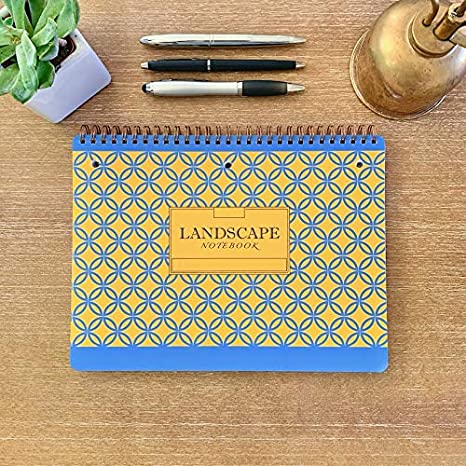
As crowdsourcing campaigns go, it was pretty casual: a low-fi video and list of three reasons Neyo was passionate about creating a landscape notebook. He felt that there should be notebooks to match the orientation of chalkboards and whiteboards so that notes taken in class or a meeting should be able to better match what’s written by the instructor or meeting leader.
Neyo also pointed out that narrow notebooks waste even more space with wide left-side margins; his notebook would be wider and the usable space would be more expansive, with minimal margins. And he was miffed about notebooks with flimsy back covers.
Flash forward (imagine the whooshing noise) to today, and Neyo has his own website and version 2 of his Landscape Notebook has debuted:
- The Landscape Notebook measures 10″ x 7.5″.
- The 80 sheets (160 pages) are college ruled.
- It has double-loop spiral binding along the top (he refers to it as O-ring, but it appears to be Wire-O) and it has a stiff back cover.
- There are three simple cover designs: solid navy blue with yellow accents, solid light blue with white accents, or a yellow and blue pattern.
- The pages are perforated slightly below the spiral binding; below that, each page is three-hole punched, eliminating any activation energy for getting your papers filed away once you tear them off the notebook.
- Each page is lightly marked with page divider indicators at the top margin to make it each for creating two, three, or five columns or sections.
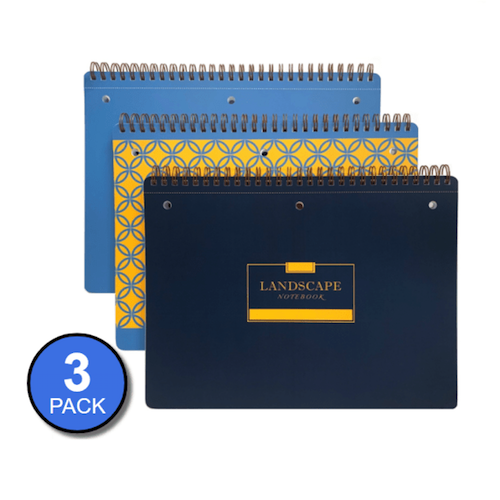
Neyo’s Landscape Notebook is available from his website: 3 notebooks for $24, 12 for $84, or 48 for $288. The site says the Landscape Notebooks are also available on Amazon, where there are priced slightly lower, but are currently out of stock.
This is the first (and least techie) of a short series on innovations in notebooks. Be sure to pop back next week to see what’s new in erasable, reusable, customizable, and even magnetic notebooks!
Organizing the Shape of Notebooks to Come: Panobook, Triangle, and Sidekick
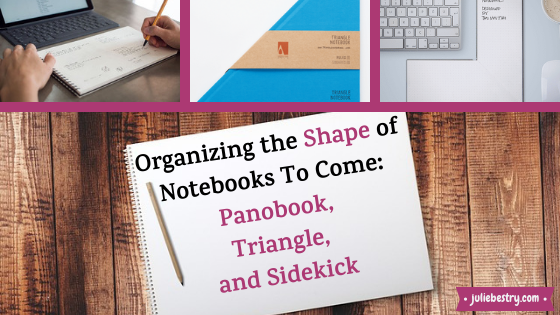
Notebooks. Bullet Journals. Diaries. Sketchbooks. Whatever you use, notebooks are essential to capturing words, feelings, designs, and brilliant ideas so they don’t fade away into oblivion.
We’ve talked a lot of notebooks here at Paper Doll HQ, everything from waterproof notebooks to notebooks for left-handers. We’ve discussed various types of hybrid paper/digital notebooks, like Ampad’s Shot Notes and Versa Crossover, TOPS’ Focus Notes, and Evernote’s Smart Notebook by Moleskine. We’ve dug into magnetic notebooks, dry-erase notebooks, and customizable notebooks.
The blog has also looked at the 5 Key Points for Organizing with Notebooks, and in Notions on Notebooks: Organize Your Paper Picks, we delved into all of the considerations to take into account when choosing a notebook solution, including: price, branding, portability, binding, paper quality, lines, and color.
We’ve even looked at the shape of notebooks before when we presented Paper Doll Surveys the (Paper) Landscape. Because, sometimes, you just want something a little different. Today, we’re going to embrace three very different notebook styles.
PANOBOOK
Most notebooks have a portrait orientation. It’s rare, other than with sketchbooks, to see a notebook with a landscape orientation. Panobook, however, takes landscape one step further and delivers a panoramic (landscape-orientation, but wider) notebook designed to sit on your desk (in that bit of space between your abdomen and your keyboard), and eventually, on your bookshelf.

Created by Texas-based Studio Neat, known for a variety of innovative products, from wooden charging docks to cocktail-making tools to video-related apps, Panobook began life as a Kickstarter and quickly gathered community support.
It’s easy to understand why. Depending on the width of your desk, you may or may not have space to the left or right of your body. But your monitor is generally straight in front of you, and so is your keyboard, so unless you have an L-shaped desk, the real estate in front of you is pretty tightly packed.
If you want to take notes, maybe you can scroll (I mean, slide) your body to the left or right, or you may have to swivel in your seat to use the left side of the desk (or the right side, if you’re left-handed) to take notes. Unless your arms are long (and your eyesight so pristine that your monitor is very far away), there’s just not that much writing space in front of you. (And I’m pretty sure you don’t want a notebook poking into your tummy.)
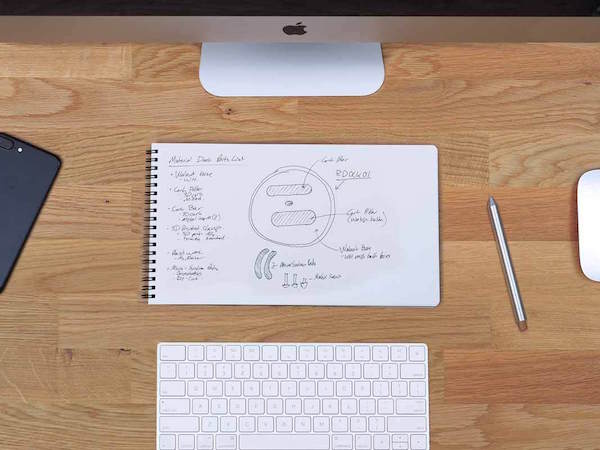
Panobook was created to solve this problem of limited space. The panoramic format, measuring 160 mm x 288 mm (6.53″ x 11.34″) is designed to sit squarely in front of, or if you prefer, behind, your keyboard. (Turned vertically, of course, it can sit to the left or right, if you have that much space. But then you’d probably be using a traditional notebook or legal pad, right?)
Panobook is made of high-quality (Finch Fine Soft White Ultra Smooth 70 lb text-quality) paper and designed to perform with a variety of writing instruments and inks without causing bleed-through or smudging. Both the front and back of Panobook are rigid, made of Neenah LaCrema 617 Charcoal-colored 50 pt black chipboard. It’s all bound with sturdy black Wire-O (12.7 mm (0.5″) diameter), so Panobook will sit flat when opened on your desk. (For some of us, this is a huge deal!)
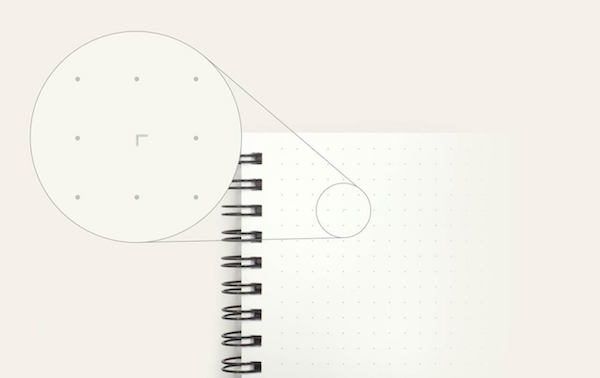
Each notebook contains 50 sheets (100 pages). Instead of being lined or blank, Panobook has a subtle dot pattern with grid spacing at 5 mm (0.20″). And there’s a quirky little twist. There are guide markers on each page that make it easy to quickly draw three rectangles on the page, sized ideally for web designers doing smartphone user interface design or creative types for doing storyboarding. There are also edge guides to divide each page and provide cues for layout. They’re subtle, so if you don’t need them, you might not even notice them.
So what do you do when you finish the notebook? Panobook is designed to let you archive your creations and comes with a slip case in a French Paper Kraft-Tone Standard White 100 lb Cover (for people who know about such things). Write on the spines to catalog your notebooks and keep your collection together on a shelf.
See the Panobook in action:
You can buy Panobook directly from Studio Neat for $20/notebook for one or two; they’re discounted to $19/notebook when you purchase three or more.
TRIANGLE NOTEBOOK
When I first saw the Triangle Notebook last summer, it seemed vaguely familiar. Back in 2012, there were quite a few posts on the design blogs about this product and it was selling at the Metropolitan Museum of Art shop. However, by the time I planned to write about it, the Triangle Notebook had already sold out and been withdrawn from the marketplace. Now it’s back in an improved form.
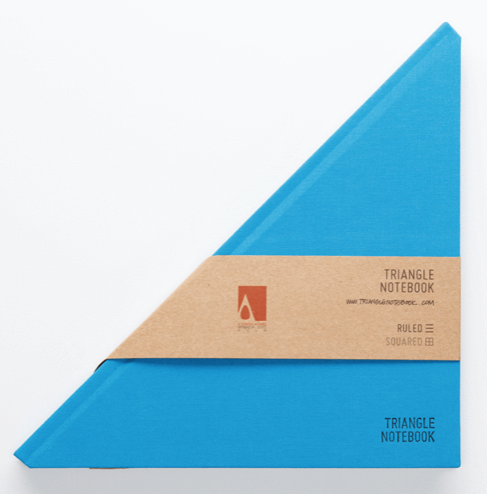
The Triangle Notebooks (both the original and improved versions) were created by Tan Mavitan, a creator based in Istanbul, Turkey and best known for his sculptures. As you can imagine, artists need someplace to collect designs and thoughts, so who better to imagine innovatively designed notebooks?
The Triangle Notebook appears to be just that: When closed, it’s a triangle. Flipped open, the notebook is square. The hard front and back covers and spine are encased in fabric, and the 160 interior (90 gr acid-free paper) sheets are narrowly ruled.
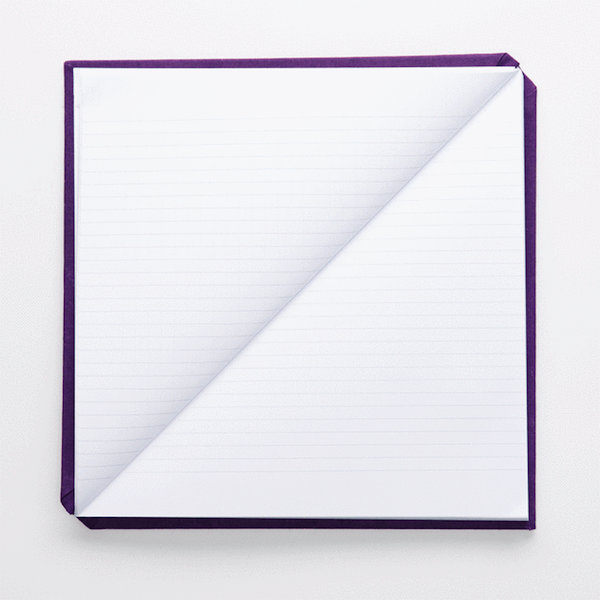
The Triangle Notebook comes in 13 solid colors, including Black, (light) Blue, Dark Green, “Green” (which looks more like chartreuse), Navy Blue, Pink, Purple, Red, Yellow, Dark Amber, Ghost White, and Mustard. There are also three Special Edition Triangle Notebooks: Triangle Thoughts (white with black avante garde style, and Yachtsman Blue (pictured below) and Yachtsman Red. All notebooks are 21 cm x 21 cm (8.26″ x 8.26″).
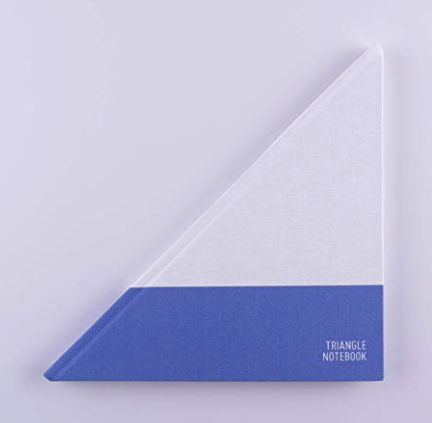
Personally, I find $33 to be a steep price, even for an admittedly lovely hardcover notebook, but my larger concern is that the pages may not lay flat when the notebook is open. Of course, at about 8 1/4″ square, you could place a small book weight in the center without obscuring too much of your content.
All versions of the Triangle Notebook are available from Amazon or from the Tan Mavitan Studio shop. The price in both venues is $33. The Studio often has discount codes listed at the top of the page; as of this writing, WELCOME2019 yields a 20% discount. However, there’s no shipping rate information on the site, and the notebooks do qualify for Amazon Prime two-day shipping, so check both options to see what works best for you.
SIDEKICK NOTEBOOK
Remember what I was saying about real estate on your desk being at a premium? Panobook isn’t the only option for handling this problem creatively. The Sidekick Notebook appears to be a mostly normal (if narrow) portrait-oriented notebook with a bottom margin cut strangely on the diagonal.
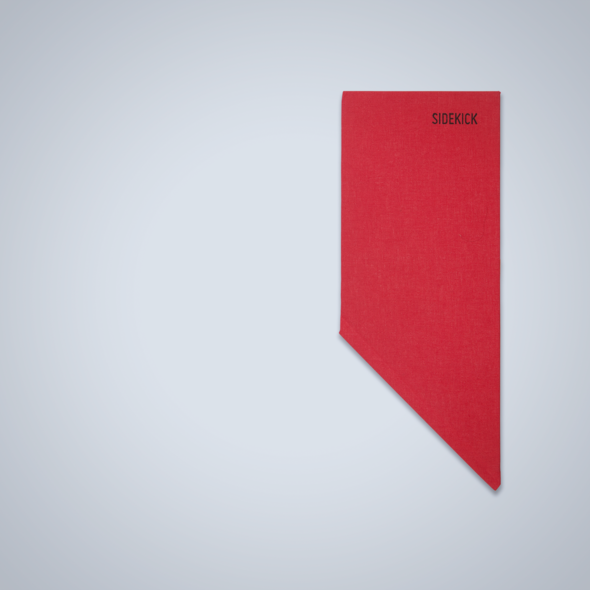
When closed, the Sidekick Notebook measures 21.5 cm x 8.5 cm (8.46″ x 3.34″). But once it’s flipped open, the Sidekick is actually an L-shaped notebook designed to hug the corners of keyboards, iPads/tablets, mousepads, books, and other square-ish items.
Instead of a portrait or landscape orientation, the Sidekick delivers both options simultaneously
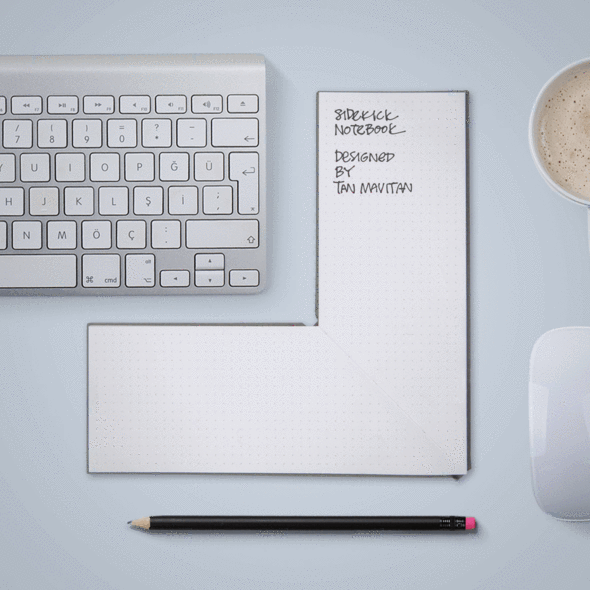
The Sidekick, which comes 160 sheets (of 90 gr acid-free paper) per notebook, has a hard fabric-encased cover and comes in four colors: Red, Black, Navy Blue, and Light Gray. The layout is dot- grid style.
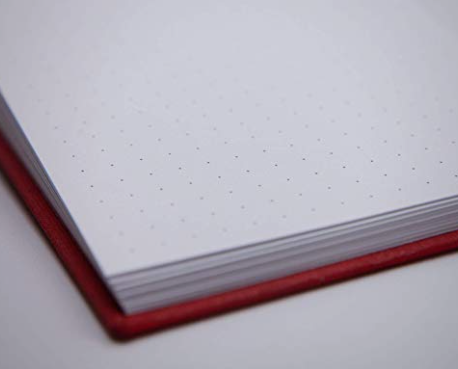
I suspect that the Sidekick won’t serve well for sketching large designs, but with both landscape and portrait writing areas, it’s good for taking notes and creating fiddly, small-detail designs.
The Sidekick is available for $24 per notebook from Amazon and from the Tan Mavitan Studio store, with the same discount and shipping caveats as noted above for the Triangle Notebook.
As always, the content you create and capture in your notebook is more important than the size, shape, color, or design. Sometimes, if a notebook is too spiffy (or expensive), we are reluctant to put anything but our “best” notions in them, which may mean procrastinating on doing anything at all.
If a unique design inspires you, embrace an unusual landscape or angle. Just give yourself permission to create first, and judge your work later.
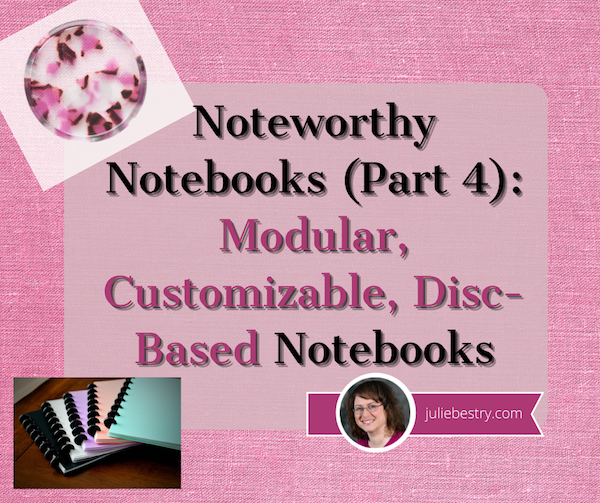

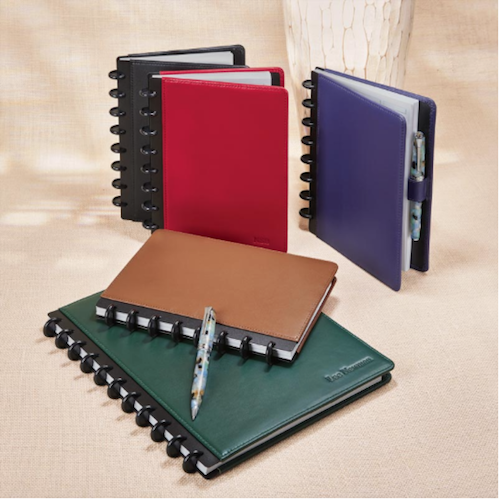
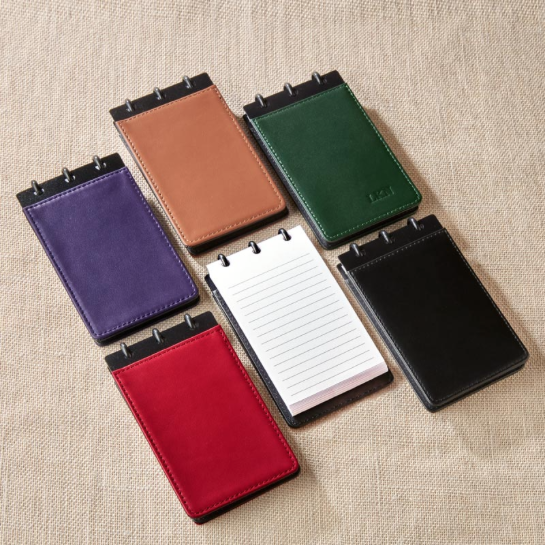
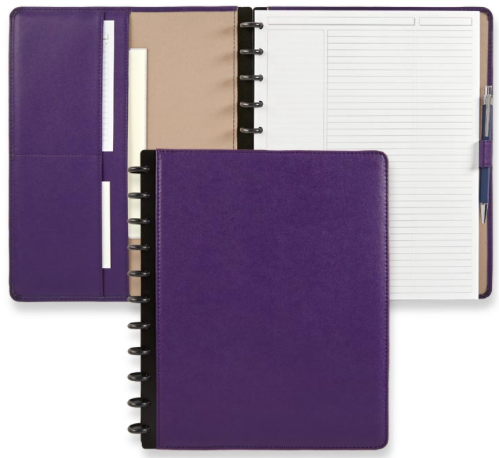 Next, once you’ve got your cover picked out, you can customize to your heart’s delight.
Next, once you’ve got your cover picked out, you can customize to your heart’s delight.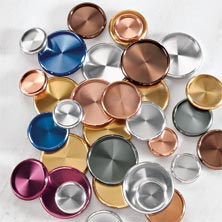
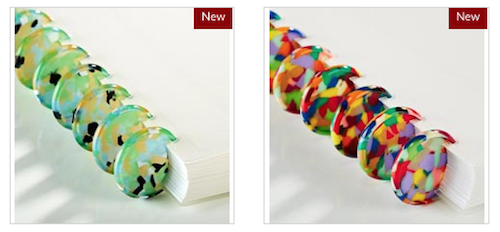
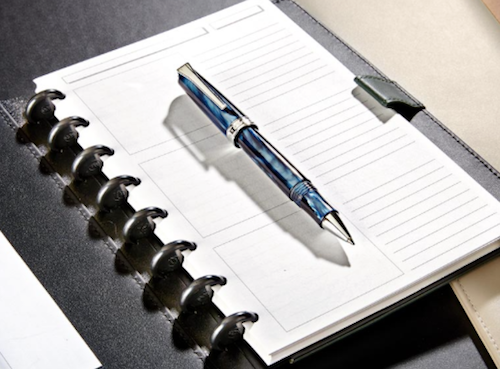
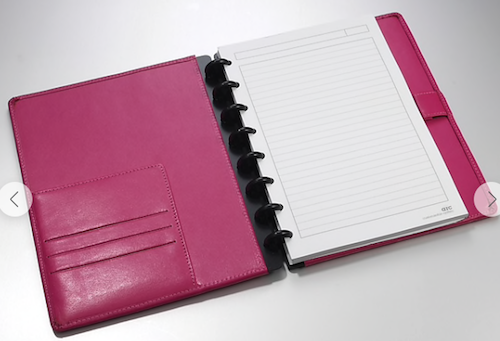
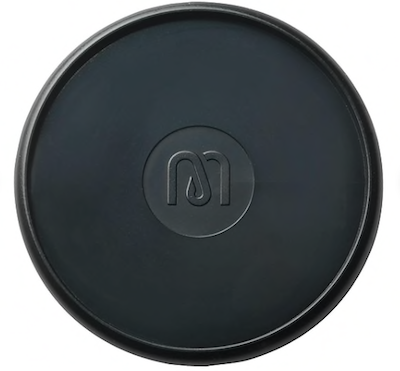
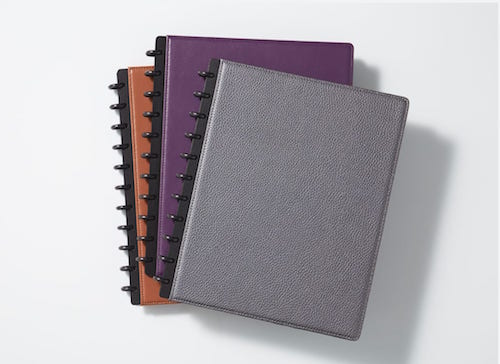
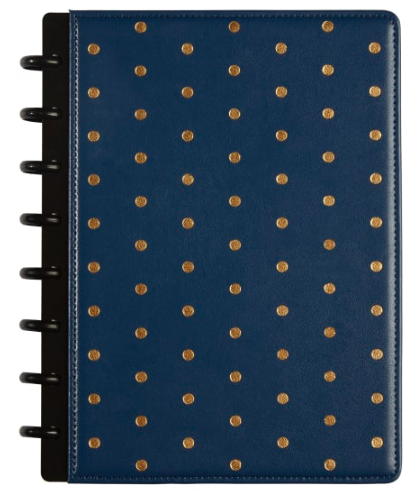
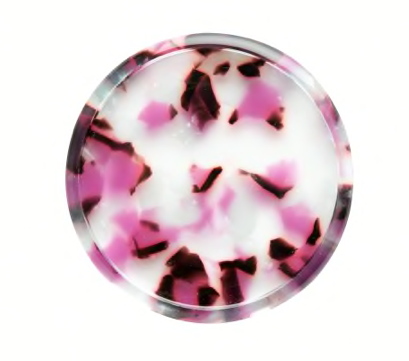
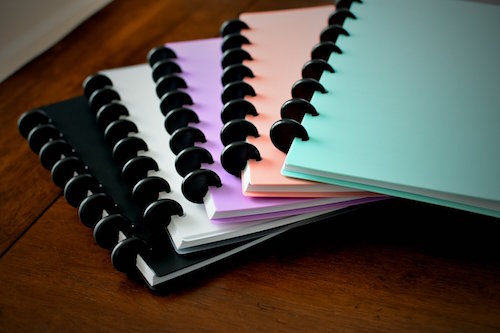


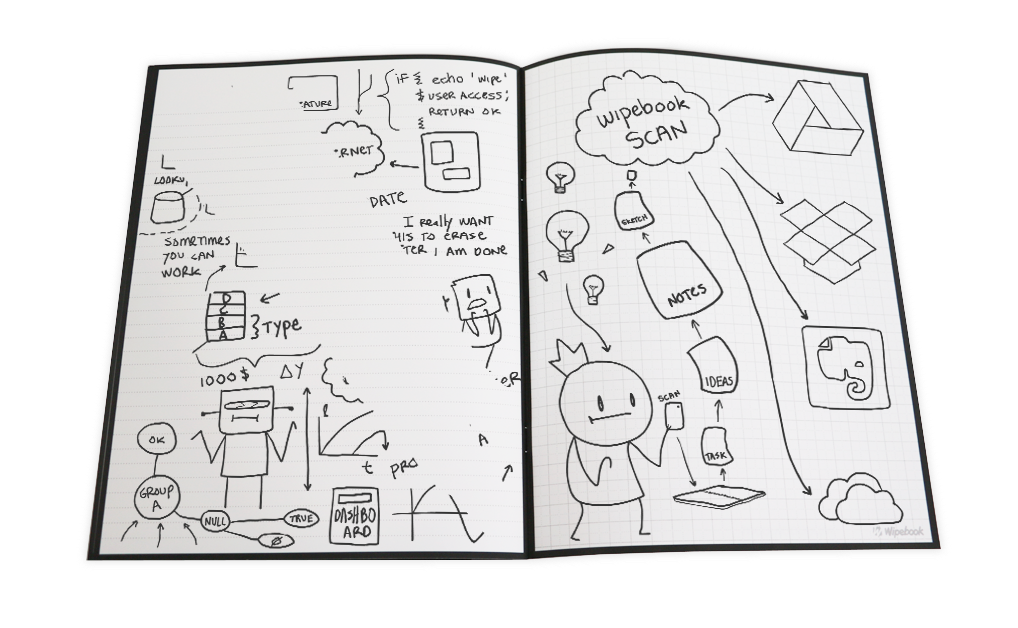




Follow Me